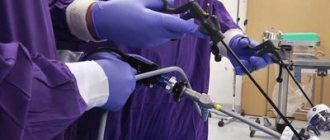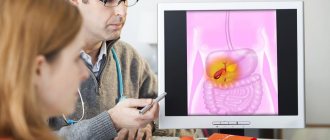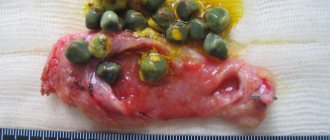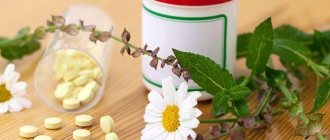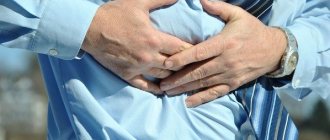Gallbladder tubing (dubazh, blind probing) is a popular procedure that will cleanse the gallbladder and its ducts, as well as speed up the outflow of bile. Cleansing is prescribed during complex therapy of cholecystitis (calculous form), duodenum, cholestatic hepatitis, and biliary tract dysfunction. In addition, the procedure helps improve intestinal motility and prevent constipation.
As a rule, dubage of the gallbladder (GB) is carried out in medical institutions using a probe. However, the procedure can be done independently after consultation with a doctor. If the rules for performing home tubing are followed, patients will experience pain and discomfort on the right side under the ribs, the gastrointestinal tract will be cleared of toxins and stagnant secretions, and digestion will be normalized.
Description of the procedure and indications
Many patients who were prescribed tubage for the first time are interested in what it is. The main goal of the treatment procedure is to remove stagnant liver secretions. During dubage, the circular muscles that surround the gallbladder relax. The duct also relaxes, which closes the outlets into the hollow organs. In addition, the smooth muscles of these organs contract.
During tubage, the patient takes choleretic compounds and at the same time warms up the area of the right hypochondrium
During tubage, the patient takes choleretic compounds and at the same time warms up the area of the right hypochondrium. This method allows you to improve the motility of the biliary tract and eliminate bile stagnation. As a result, the functionality of the gastrointestinal tract and other digestive organs is normalized. Thus, with the help of dubage, the following goals can be achieved: cleanse the gallbladder, accelerate the outflow of liver secretions, and prevent the formation of hard stones.
The choleretic composition stimulates the contraction of the muscular layer of the gallbladder, after which the organ and its ducts are quickly freed from stagnant secretions. The procedure is carried out to eliminate stagnant processes, against the background of which the likelihood of cholelithiasis increases. That is, tubing is often performed to prevent cholelithiasis.
Tubage is a serious procedure that is not recommended to be carried out thoughtlessly; it is carried out strictly according to the doctor’s indications.
Dubazh is prescribed in the following cases:
- with acalculous cholecystitis with a chronic course;
- biliary tract dysfunction;
- disorders of liver function;
- chronic pancreatitis;
- inflammation of the duodenum (chronic form);
- cholestasis (stagnation of bile in the gallbladder).
Dubazhi are effective for constipation caused by weakening of the smooth muscles of the intestines. After the procedure, intestinal motility is normalized, the functionality of the digestive system is improved, and the removal of liver secretions from the gallbladder into the duodenum is accelerated. Blind probing is suitable for healthy patients who are malnourished.
Evaluation of results
Most often, instrumental probing is carried out for diagnostic purposes. Therefore, after collecting bile, it is analyzed. At the same time, attention is paid to its color, transparency, and viscosity. Only in the first portion taken from the duodenum is a little sediment allowed. It may contain sodium salts, cholesterol, leukocytes, and epithelial cells. All other bile should be transparent.
Tube B contains a large number of white blood cells and mucus. This indicates the presence of inflammation of the gallbladder. And the presence of cholesterol may be a sign of stones. If there are a lot of white blood cells in the liver bile, it means that the inflammatory process has affected the liver. Chronic cholecystitis is indicated by light bile in portion B. If it is poorly separated after the administration of magnesium sulfate or is very dark, it means that the patient has biliary dyskinesia.
Studying the composition of bile also helps to identify the presence of bacterial contamination, for example, staphylococcus, E. coli, enterococci. In addition, this method allows you to detect parasites that often settle in the liver: lamblia or flukes.
Preparation
Blind probing of the gallbladder at home is carried out with mineral water, magnesia, sorbitol, etc. Many patients do not know how to do tubage correctly and, without understanding the intricacies, carry out the procedure. And this is fraught with negative consequences. You need to properly prepare for blind probing.
Before cleaning the gallbladder, you should consult your doctor.
Preparation for probing:
- Before the procedure, you need to visit a doctor who will advise you on its implementation. Another main condition is an ultrasound of the gallbladder, because if there is at least one stone (even a small one) in the organ, then dubage cannot be performed. In addition, the doctor examines the patient for contraindications.
- On the eve of cleaning the gallbladder (3 days in advance), you need to follow a diet. The patient should give up meat and switch to milk and plant products. It is recommended to include fruits, vegetables (freshly squeezed juices from them), cereals, fermented milk products with a low percentage of fat, and still mineral water in your diet.
- Fatty foods that are difficult for the digestive organs, alcoholic drinks, strong coffee and tea should be excluded from the menu. It is forbidden to drink soda, use seasonings and sauces.
- Before cleaning, the patient must drink at least 2 liters of purified water without gas.
- 24 hours before cleaning, you need to exclude baked goods, potatoes, vegetables containing coarse fiber, and legumes from the menu. The list of restrictions includes foods rich in fast carbohydrates (confectionery).
- It is better to plan the treatment event on the weekend so that you do not have to leave the house. Proper tubing is carried out in the morning on an empty stomach.
There are 2 options for blind probing of the gallbladder: active and passive. The first option involves vigorous activity for 15 minutes after taking choleretic solutions. The patient can squat, bend, walk in place, etc. During passive dubage, the patient, after drinking liquid, should lie on his right side, having previously placed heat under him.
Features of patient preparation and action
The benefits for the liver and gallbladder from blind probing are beyond doubt, but manipulation requires preparation, proper implementation and subsequent “exit” from therapy.
Preparation includes a number of activities. First of all, you need to make sure that there are no stones in the gall bladder, and the presence of stagnation is identified. The diet is changed in 2-3 days. It is necessary to give up heavy foods and switch to plant-based products - this is an important point and cannot be excluded.
The diet does not have strict restrictions; there are a number of foods that a person can eat. The following products should not be consumed:
- Fatty foods.
- Conservation.
- Vegetable oil.
- Fried foods.
- Broths – fish, meat.
- Buns, candies and other sweets.
- Some varieties of fermented milk products.
- Sour berries, fruits.
Preparation includes a ban on the consumption of any alcoholic beverages, carbonated drinks, tea and coffee. You can only drink clean still water.
With mineral water
The question of how to perform gallbladder tubing using mineral water is quite relevant. Cleaning is carried out in the morning on an empty stomach. It is necessary to prepare everything that is needed for blind probing in the evening. If the patient is cleaning for the first time, then it is better to buy mineral water without gas (the degree of mineralization is weak or medium). If you are in doubt about the choice of water, consult a doctor who will tell you which brand you should pay attention to. As a rule, Essentuki, Borjomi, and Narzan are used for cleaning the gastrointestinal tract. If the patient bought sparkling water, then in the evening it needs to be opened so that the gas evaporates before the morning.
During tubage, mineral water without gas is used.
Instructions for tubaging with mineral water:
Probing of the gallbladder + video
- Pour mineral water into a saucepan and put on fire until its temperature rises to 40–50°.
- Heat regular water and pour it into a heating pad, which should be wrapped in a cloth before use so as not to cause a burn. It is better to replace the rubber heating pad with an electric one. Since it does not cool down, the patient can independently regulate the temperature.
- While standing, drink 200 ml of heated liquid in small sips, and then lie on your back or right side, after applying a heating pad to the area of the right hypochondrium. Warming up will help relax the sphincter of the gallbladder and bile ducts, after which stagnant liver secretions will be released more quickly.
- After 5 minutes, drink a few more sips of mineral water (while standing), lie down again and warm the gallbladder area.
- The total amount of mineral water drunk should be 500 ml. Drink it in small sips at intervals of 5 minutes, warming the area on the right under the ribs.
- After drinking all the liquid, you need to lie on your right side with a heating pad and remain in this position for another 20 minutes.
After the above steps, the patient may experience pain in the gallbladder area. This is due to the fact that the muscles of the gallbladder sharply contract under the influence of the choleretic composition. An antispasmodic (No-shpa, Drotavreni, Spazmalgon) will help eliminate unpleasant sensations.
Tubbing the gallbladder with mineral water will not cause any difficulties, the main thing is to strictly follow the instructions. Cleaning lasts from 1 to 1.5 hours. After the first procedure, you need to take a break for 10 days, and then you can do another dubage.
Choleretic compounds exhibit a mild laxative effect, so the patient’s stool may turn greenish. However, do not worry, since the change in the color of the stool is associated with the release of liver secretions.
Blind probing is especially effective in case of strong congestive processes in the gallbladder. After the procedure, discomfort on the right side under the ribs, bitter taste in the mouth, belching, etc. disappear.
Technique of duodenal intubation
This procedure is carried out using a duodenal probe. This is a thin rubber tube, at the end of which there is a metal olive with several holes. Before inserting the probe, determine to what depth it needs to be lowered. On average, for an adult it is 70-90 cm.
The patient sits on a chair, covers his chest with a towel, and holds a saliva tray in his hands. The end of the probe is processed and placed on the root of his tongue. You need to tilt your head to your chest and make swallowing movements. At the same time, the nurse advances the probe. The patient needs to breathe deeply through his nose, this will help prevent the gag reflex. When the probe moves to the 40 cm mark, the patient needs to lie on his right side on a heating pad.
In this case, you need to continue to swallow the probe, while it gradually moves into the duodenum. This may take about an hour. You can check the position of the probe by taking some of the contents from it with a syringe. If it is a cloudy liquid, then the tube is still in the stomach. The test can also be done using fluoroscopy or by introducing some air into the probe. Usually the probe reaches the duodenum at around 80-90 cm.
After this, the bile is collected, and this is done in three stages, collecting it in different test tubes:
- The first portion is bile, located in the duodenum. It is light in color and contains admixtures of pancreatic juice. It can take about half an hour to collect a portion A of 15-40 ml.
- After this, you need to stimulate the release of bile from the gallbladder. To do this, a warm solution of magnesium sulfate or xylitol is injected into the probe. The tube is clamped for 10 minutes, during which the medicine will have its choleretic effect. Portion B is collected in another test tube. This bile is greenish and thick. Usually 50-60 ml is collected, but its amount can increase in the presence of congestion.
- The last portion is bile coming from the liver. It is light yellow and has no impurities. Its volume is usually no more than 30 ml.
After removing the probe, you must rinse your mouth. During the first two hours, the patient must be under the supervision of a doctor, he needs to lie down, so it is better to carry out the procedure in a hospital. It is necessary to measure the patient's blood pressure and monitor the pulse
When probed, bile is collected in three different tubes
Cleansing with sorbitol
If the first cleansing with mineral water was effective, then you can perform a blind tube of the gallbladder with sorbitol. To do this, add a little natural sweetener to the mineral water. This procedure allows you to cleanse the liver, gallbladder, its ducts and kidneys, and prevents the formation of sand and stones in the organs.
Sorbitol with mineral water cleanses the liver, gallbladder, its ducts, kidneys, warns cholelithiasis
Blind Probing Stages:
- Dilute 1 dessert spoon of sorbitol in 150 ml of still mineral water. Stir thoroughly to dissolve the powder.
- Drink the choleretic solution in small sips over 10 minutes, and then wash it down with 100 ml of mineral water.
- Lie on your right side, applying a heating pad to it in advance, pull your legs towards your stomach.
- After 1–2 hours the procedure is completed.
To determine the correctness of the treatment, pay attention to the consistency of the stool. Dubazh using sorbitol has a pronounced laxative effect. Feces should be liquid, mixed with greenish clots of liver secretion. An attack of biliary colic is treated with antispasmodics.
Tube with sorbitol lasts about 2 hours, and the urge to stool appears at intervals of about 20 minutes.
With magnesia
Blind probing with magnesium is done according to the same scheme as the previous procedure. The only difference is that 1 tbsp is added to 220 ml of heated mineral water. a spoonful of magnesium sulfate. However, this drug is poorly soluble in water, so before taking it, it must be thoroughly stirred to obtain a completely clear solution. The liquid should be drunk slowly, in small sips. It is worth considering that the composition is quite salty, but it is prohibited to drink it with any other liquid.
To clean the gallbladder and eliminate stagnant processes, use mineral water with magnesium
Some patients complain that immediately after drinking a solution with magnesium, nausea and discomfort appear on the right side under the ribs. As in previous cases, an antispasmodic will help. Take the tablet with water (minimum amount), lie on your right side and warm it with a heating pad. A tube with magnesium does not take longer than 2 hours; the desire to empty the intestines may appear every 20 minutes. If there are greenish inclusions in the stool, then the procedure was carried out correctly.
The decision on the number of procedures and the frequency of their implementation is made by the doctor, taking into account the condition of the gastrointestinal tract. To effectively cleanse the organ, you need to perform dubage every week for 2-3 months. To prevent gallbladder diseases, cleaning is done once every 4 weeks.
After the treatment, the patient must eat properly for 48 hours. Therefore, you should avoid foods that are fatty and difficult for the digestive system. The daily diet should consist of liquid porridges, boiled or stewed vegetables, salads with the addition of vegetable oil, fruits, and fermented milk products with a low fat content. It is also allowed to eat lean meat and fish. The patient should drink 2 liters of fluid per day.
Tubing is performed on a child only for medical reasons after an ultrasound scan. Children are allowed to use choleretic formulations based on mineral water or mineral water with magnesium. The latter solution demonstrates a more pronounced effect. The dose of magnesium sulfate is calculated by the doctor taking into account his body weight.
If the cleaning is done correctly, then secretions will begin to actively come out of the gallbladder. After several procedures, a person feels light, the pain on the right under the ribs, nausea, bitterness in the mouth disappear, appetite and digestion are normalized.
Fractional duodenal intubation
For a more accurate assessment of the state of the biliary system, fractional probing of the gallbladder is also used, which consists of five stages:
How can you check your stomach without swallowing your intestines?
- First, bile is taken from the ducts for 20 minutes. During this time, 20 ml should accumulate; if more, this indicates hypersecretion of the gallbladder.
- Then introduce a solution of magnesium sulfate and apply a clamp to the probe. After removing it, bile should begin to be released no later than 5-6 minutes. If it is not present during this time, it means that there is an obstacle to its outflow or the tone of the gallbladder is increased.
- Over the next 3 minutes, 3-5 ml of bile should be released. If there is more of it, this indicates hypertonicity of the sphincter of Oddi.
- Then bile is taken from the gallbladder. In half an hour, 30-70 ml should be released. A different amount may be a sign of impaired bladder motility.
- The last portion is secreted by the liver bile. In 15-20 minutes it should accumulate up to 30 ml.
How duodenal intubation is performed to identify Giardia is clearly shown in the following video:
Active tubing
This blind probing option is suitable for healthy patients who are malnourished.
During active exercise, the patient should perform simple physical exercises
In the evening before the procedure, you need to open a 1 liter bottle of mineral water so that the gas evaporates. As in previous cases, cleaning is carried out in the morning on an empty stomach. The patient slowly drinks 3 glasses of water, the temperature of which should be in the range from 20 to 25°. After drinking liquid, a person does not lie down, but begins to perform simple physical exercises (for example, squats, bends, abdominal exercises, etc.). 20 minutes after vigorous activity, you need to drink another 440 ml of water, after which you need to continue doing exercises for 10 minutes.
In addition to mineral water and choleretic agents for the cleansing procedure, you can use herbal decoctions (immortelle, tansy, rose hips, corn silk, plantain, etc.). Olive oil mixed with lemon juice is also used for this purpose. It is better to entrust the decision on choosing a choleretic composition to your doctor.
Recommendations for preparing a child for sounding
|
It is advisable to carry out the procedure for clearing bile after a week-long cycle of a vegetarian diet and fractional meals. In this case, the body will be maximally prepared and will be able to more easily tolerate blind probing.
To restore the functioning of the gallbladder, it is also recommended to follow a diet after the procedure. The procedure is usually carried out at home.
Blind probing for a child can be done using warm mineral water. The bottle of water should be opened and left overnight; in the morning, 2-3 tsp is added to the mineral water. sorbitol or 1-2 tbsp. magnesia solution. For cleaning, 2-3 tsp is also often used. olive oil. In addition, freshly squeezed juices are perfect. For example, grape, carrot and beetroot.
You can also blindly probe a child with an egg. To do this, beat 2 egg yolks with 2 tbsp. sugar, then add 1 tsp. honey The resulting mixture must be used immediately after preparation, washed down with warm water.
After cholecystectomy
It often happens that after an exacerbation of cholelithiasis, the gallbladder is removed. Then the digestive system must adapt to new operating conditions. When the gallbladder is removed, it is important to establish a regular flow of liver secretions into the duodenum and prevent stagnation.
For a patient without a gallbladder, it is useful to carry out blind probing, which does not allow stagnation of bile. Cleaning is done regularly, but only 2 months after cholecystectomy. To begin with, use mineral water, if the patient feels normal after several procedures, then doubazh with magnesium sulfate or xylitol.
The frequency of procedures for patients who have undergone cholecystectomy is determined by the attending physician. In this case, the specialist must monitor the patient’s condition. To support the digestive organs after removal of the gallbladder, the patient must not only undergo tubing, but also follow a strict diet.
What do you need to know before performing blind probing?
Basic information about the gallbladder
Problems with the gastrointestinal tract disrupt the functioning of the entire body. Therefore, as soon as the biliary system begins to malfunction, it is necessary to act, as this can lead to serious complications.
There are many drugs used in medicine that can successfully solve the problem of bile stagnation. But many medications have side effects, so when one area is treated, another suffers. To avoid having to undergo treatment, you need to carry out preventive cleansing of the body in a timely manner.
One of these methods will be blind probing. This method is quite safe for most organs in the human body. Most often, natural remedies are used for blind type probing.
Precautionary measures
Blind probing is a serious medical procedure that has its contraindications:
- Housing and communal services With stones in the gallbladder, choleretic compounds can cause displacement of stones and blockage of the bile ducts. Then you cannot do without urgent surgery.
- Exacerbation of inflammation of the gallbladder.
- Ulcer of the stomach and duodenum.
- Exacerbation of chronic diseases (gastritis, gastroduodenitis, inflammation of the pancreas or kidneys).
- Kidney stone disease.
- Hepatitis.
- Infectious diseases with an acute course, accompanied by fever.
Tubage is not recommended for patients during menstruation, as well as for pregnant and lactating patients. This restriction applies to patients with disease of the pylorus of the stomach, which is accompanied by the return of bile from the duodenum into the esophagus.
Contraindications for carrying out
Despite the safety of tubage, it is not recommended for everyone.
There are also absolute contraindications for blind probing. The main one is stones in the biliary system. Even if there is a small number of them, tubing is prohibited, since some products can lead to blockage of the bile ducts, and this can lead to very serious complications. Urgent hospitalization and even surgical intervention will be required. It is possible that the specialist will have to remove the entire gallbladder.
That is why, before deciding to undergo tubing, you should undergo a thorough examination by a specialist. An ultrasound examination is often sufficient to detect the presence of stones.
Peptic ulcer disease, both of the stomach and duodenum, is also considered a contraindication. With increased bile rejection, increased irritation of these organs is noted. If the mucous membrane is damaged, this can cause complications of peptic ulcer disease. This is a very dangerous situation.
There are also special recommendations that relate to blind probing. Women should not undergo tubing within 7 days before their expected menstrual period. This can cause increased menstrual bleeding and severe PMS pain. Tubage is not recommended during pregnancy.
